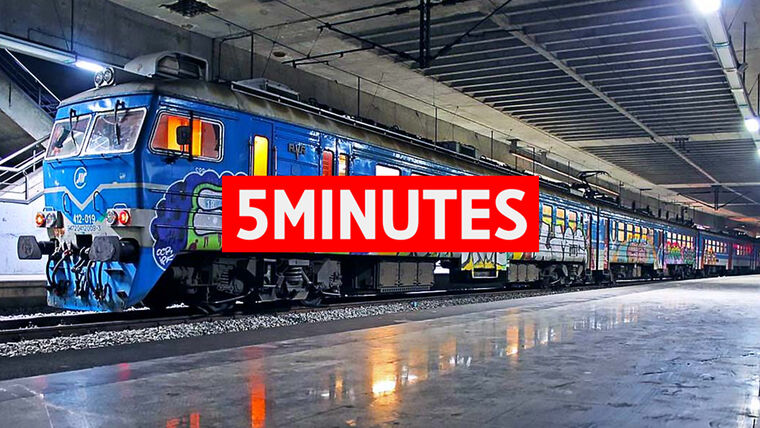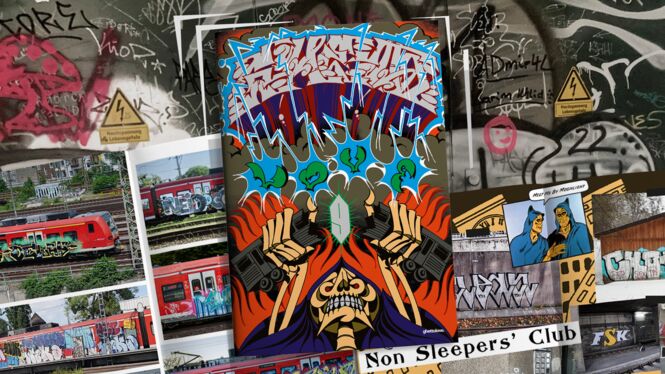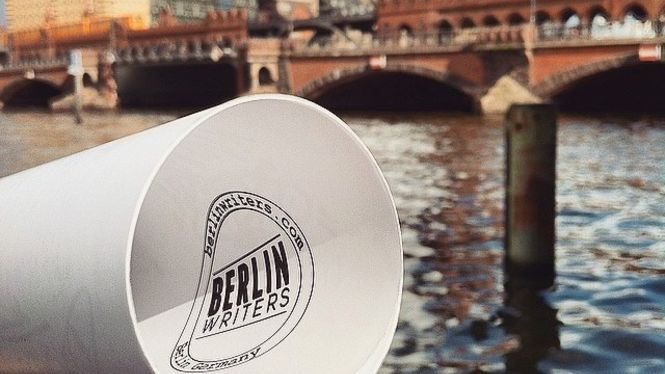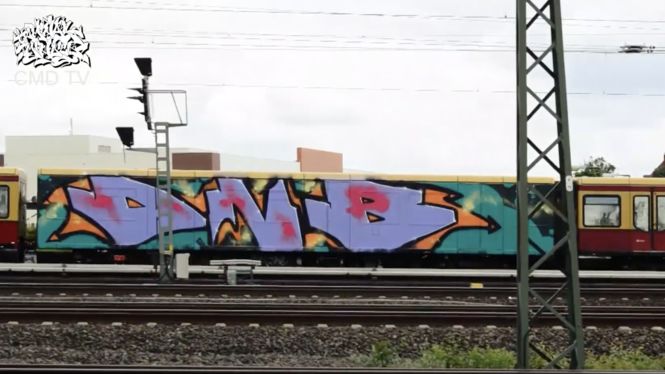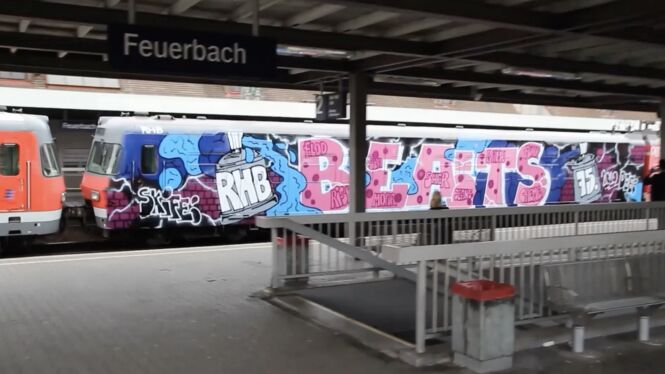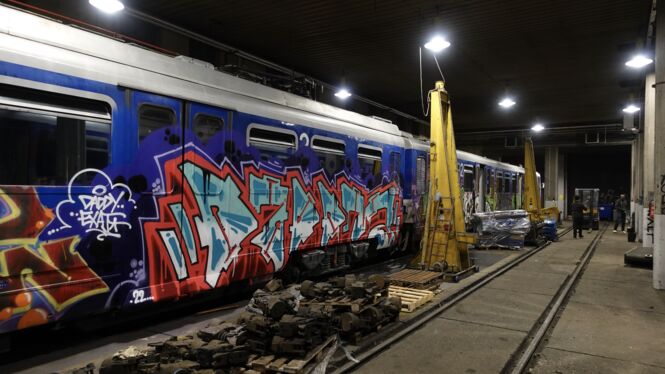Vor zehn Jahren ging das vierminütige Video LOVE AND SECURITY vom Kollektiv A.ACTIVITIES aus Wien online, nachdem es im Filmprogramm des Werkleitz Jubiläums Festivals “Utopien vermeiden” im Jahr 2013 gezeigt wurde. Eine künstlerische Arbeit in Form eines Kurzfilms, in dem nackte Menschen in U-Bahn Layups zu sehen sind, die als lebende Schablonen herhalten und von weiteren Menschen mit Farbe bespritzt werden. Auf den Abstellgleisen der Wiener Linien wurden Feuerlöscher zum Pinsel und die U-Bahn mit nackten Körpern zur Leinwand. Das Video ging damals viral und löste eine Welle der Empörung im Wiener Mainstream und teils auch der Graffitiszene aus, wurde mehrfach auf YouTube und anderen Plattformen gesperrt. Nie zuvor hat ein Video so polarisiert wie LOVE & SECURITY. Eine Interpretation des heute nicht mehr aktiven Kollektivs hat sehr lange auf sich warten lassen: ein wirkungsvoller und ästhetischer Akt des zivilen Ungehorsams
“Die Untergrundbahn ist ein mächtiges Symbol. In der Graffiti-Szene hat die U-Bahn quasi einen mythologischen Status, als schwer erreichbares Ziel und als Sinnbild für den Ursprung von Graffiti im öffentlichen Nahverkehr von New York. Für alle anderen ist die U-Bahn etwas, das den Stadtbewohnern dient, das wir täglich sehen und anfassen, wenn wir die Bahn nehmen. Und doch ist die U-Bahn irgendwie unerreichbar. Sie wird in Tunnels unterhalb der Stadt versteckt und von Sicherheitskräften, Kameras und der Polizei beschützt. Jeder Kontakt mit der U-Bahn folgt einem exakten und festgelegten Muster, und jede Bewegung, die von diesem Muster abweicht, ist verboten. Als Mal-Untergrund ist die U-Bahn tabu. Um das Video Love and Security zu drehen, sind wir in das Tunnelsystem der Wiener U-Bahn eingebrochen. In diesem Moment waren wir verletzlich und ungeschützt, nackte Menschen zwischen gigantischen Stahlwaggons, Überwachungssystemen und elektrischen Bahngleisen, lediglich mit Farbe ausgestattet. Vor Ort, in der Konfrontation mit der unerreichbaren U-Bahn, mit unseren Ängsten und den verschlossenen Türen hinter uns, haben wir unsere Spuren hinterlassen und mit ihnen eine einfache und klare Botschaft: Wir waren hier. Wir existieren. Für die öffentlichen Nahverkehrsbetriebe hat die Makellosigkeit der Züge höchste Priorität. Keine U-Bahn geht mit Farbe beschmiert in Betrieb. Durch das Filmen dieser Aktion und die Veröffentlichung des Videos haben wir sichergestellt, dass unsere Spuren nicht auf Nimmerwiedersehen verschwinden. Wir hoffen, dass alle, die das Video sehen, es im Kopf haben, wenn sie die U-Bahn betreten. Unsere Malereien haben niemals die Stadt bereist, aber bewegen sich ewig im Internet.” (A.ACTIVITIES)
Ich bin bis vor einiger Zeit davon ausgegangen, dass diese Arbeit zum Aktionskünstler Yves Klein referiert, der Ende der 1950er Jahre Anthropometrien mit Modellen, die nackt und mit blauer Farbe getränkt die Leinwand mit ihrem Körper bemalten. Der Anthropometrie Performance der Blauen Epoche, zu der ein Orchester ein von Yves Klein komponiertes Stück einspielte. Mir ist vor zehn Jahren aber noch nicht aufgefallen wie clever und effektiv das Kollektiv diese Performance damals mit dem Modus Operandi des Subway Graffiti und zivilen Ungehorsams kombiniert hat.
LOVE AND SECURITY enthielt auch Zitate, die zu Klassikern geworden sind, wie “Generation central station, 30 year old kids still lost in transportation” oder “It’s a pity only security see our graffiti.”
Ten years ago, the four-minute video LOVE AND SECURITY by the collective A.ACTIVITIES from Vienna went online after being screened in the film program of the Werkleitz anniversary festival “Utopienavoidance” in 2013. An artistic work in the form of a short film featuring naked people in subway layups that act as living stencils and are splattered with paint by other people. On the sidings of the Wiener Linien, fire extinguishers became brushes and the subway with naked bodies became a canvas. The video went viral at the time and triggered a wave of outrage in the Viennese mainstream and partly also in the graffiti scene and was banned from YouTube and other platforms. Never before a video polarized as much as LOVE & SECURITY. An interpretation of the collective, which is no longer active today, was awaited for a long time to come – an effective and aesthetic act of civil disobedience
“The subway is a powerful symbol. In graffiti culture, the subway has a mythological status as a hard to reach target, and as a reminder of graffiti’s origins on the New York public transit lines. For every one else, the subway is something that belongs to the city’s inhabitants, something that we see and touch every day as we take the train. Still, the subway is out of reach. It is hidden away in tunnels under the city and protected by security, cameras and police. All contact with the subway follows an exact and constructed pattern and any movement out of that pattern is prohibited. As a media for painting, the subway is taboo. We broke into the Vienna subway system to record the video Love and Security. In that moment we were present as naked humans, vulnerable and exposed, among giant steel cars, surveillance systems and electric tracks, equipped with nothing but paint. On the spot, confronted with the untouchable subway, with our fears and the closed doors behind us, we left our traces along with a message that is simple and clear: We were here. We exist. The public transport authorities treats the immaculacy of the trains as their highest priority. No subway will go into traffic with paint on it. By filming the act and publishing the video, we made sure that our traces will never disappear. It is our hope that anyone who has seen the images will keep them in their mind as they go on the subway. Our paintings may have never travelled through the city, but they will travel through the internet forever.” (A.ACTIVITIES)
In the past years I assumed that this work refers to performance artist Yves Klein, who in the late 1950s created anthropometries with models who were naked and soaked in blue paint and painted their bodies on the canvas. The Anthropometry Performance of the Blue Epoch, to which an orchestra played a piece composed by Yves Klein. But ten years ago I didn’t realize how cleverly and effectively the collective combined this performance with the modus operandi of subway graffiti and civil disobedience.
LOVE AND SECURITY also contained quotes that have become classics, such as “Generation central station, 30 year old kids still lost in transportation” or “It’s a pity only security see our graffiti.”

René/ilovegraffiti.de




